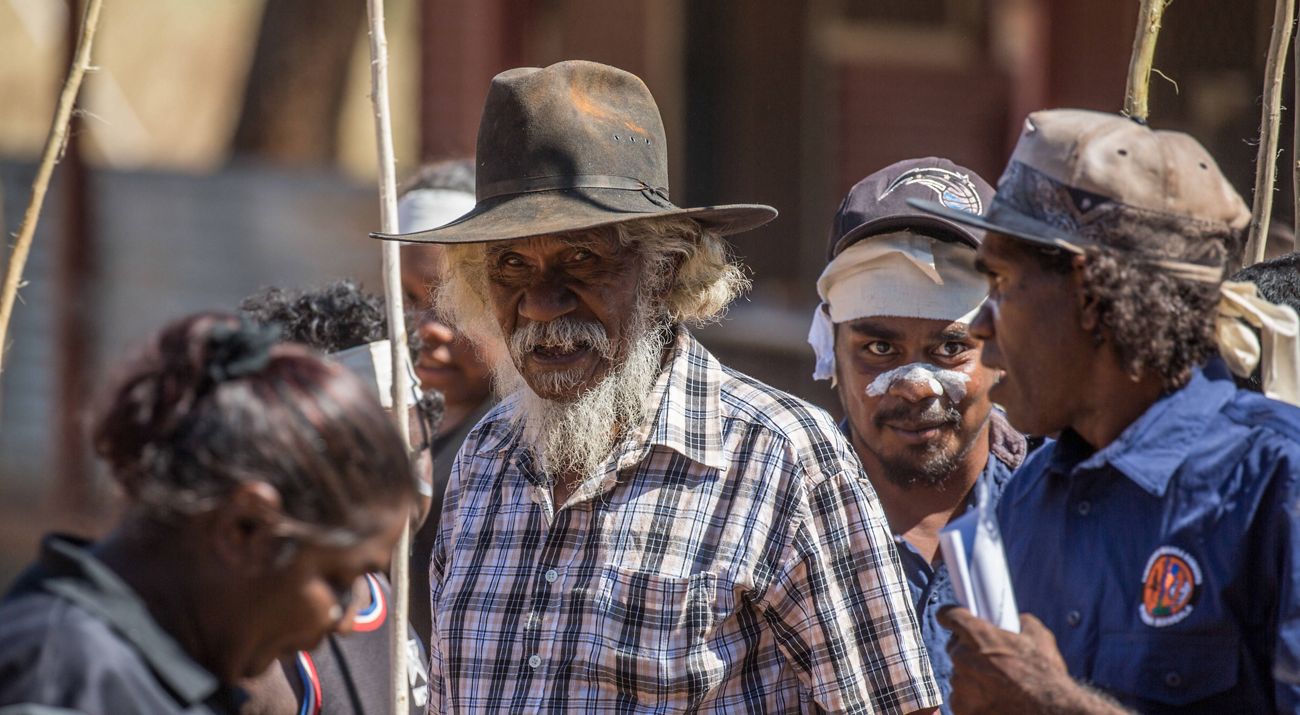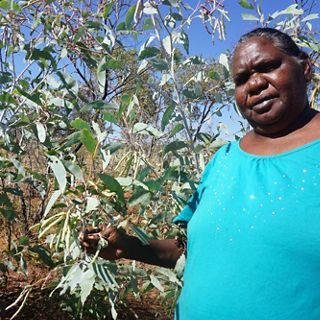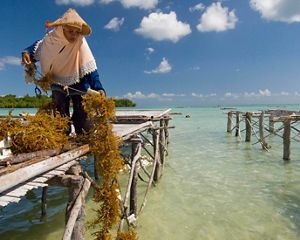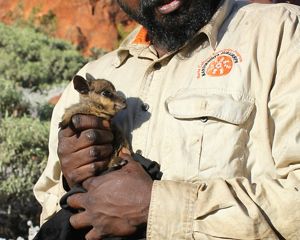Australia's northern tropical savanna is considered the largest intact savanna in the world with globally-significant biodiversity. Part of this savanna is the mighty Mardoowarra (Fitzroy River) in the Kimberley Region of far north Western Australia. It runs through the rugged and beautiful traditional Country of the Nyikina and Mangala people. It’s one of the few places left in northern Australia where you find the endangered Northern River Shark, and three vulnerable species of freshwater sawfish, along with rock-wallabies and bilbies. But it’s under threat.
The Nyikina and Mangala people are concerned about the impact on their Country from activities like wild fires, mining, exploration, unmanaged tourism and irrigated agriculture, all of which can cause damage to delicate cultural sites, precious water sources, and threaten plants and animals.
The prospect of large-scale irrigated agriculture represents a significant potential increase of consumptive water use. If it proceeded it would likely require dams, diversions and off-stream storage facilities. The high variability of water in the river means that proposals from developers may exceed the water flow in dry years which could then have a devastating effect on the local ecology.
Planning for Country and Culture
With the support of The Nature Conservancy, the Walalakoo Healthy Country Plan was developed by Nyikina Mangala Traditional Owners. Walalakoo means “a lot of people” in Nyikina language. The purpose of the Healthy Country Plan is to guide Nyikina Mangala Rangers to make decisions that look after Country; provide a strong future and livelihood for their people and communities, and implement land management practices guided by both traditional ecological knowledge and western scientific knowledge.
The plan is not only for Rangers and Traditional Owners, but for government agencies, researchers, industry and the wider Australian community, so they can better understand and respect the rights and responsibilities of Nyikina Mangala Country. The plan covers the Nyikina Mangala native title area covering 26,100 km2, including the National Heritage listed Fitzroy River, its wetlands and tributaries that stretch to the Great Sandy Desert.
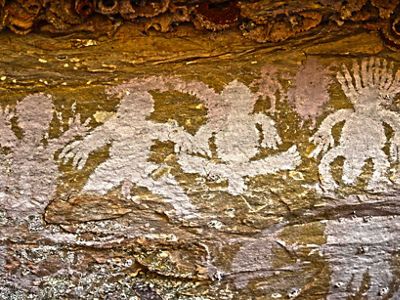
Quote
The Healthy Country Plan we came up with together helps our rangers look after Country better using both traditional knowledge and kartiya (western) science.
The Healthy Country Plan provides a clear illustration that the river is part of a large ecosystem in which every component has its role. The plan and the process of creating it was important because it puts Traditional Owners at the forefront of making decisions about the management of their own country.
Healthy country plans are powerful tools in providing guidance for the sustainable management of Country for people and nature. Few unified frameworks exist to guide the integration of biodiversity and social/cultural values into environmental impact assessments or development proposals, despite Indigenous people owning or having legal title to large parts of Australia. Healthy country plans recognise the rights of people to maintain their social and cultural identity—that is one of the reasons why their Healthy Country Plan is so critical for the Nyikina Mangala people.
Quote: Damien Parriman
We’re grateful for the support of a range of partner organisations, including The Nature Conservancy, who have dedicated a considerable amount of time and funds to ensure the development of the plan and its launch is a success.
7 threatened animals of Nyikina and Mangala Country
Our research of the Nyikina Mangala native title area found species listed as rare or threatened by state and national legislation that include 32 animals: 9 mammals, 15 birds, 6 fish, and 2 reptiles and 24 plants as well as 18 migratory shorebirds protected by international agreements. Here we introduce some of those species.
1. Ghost Bat
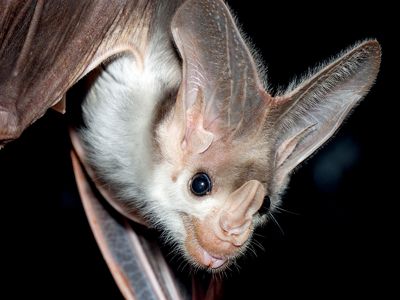
Status: Vulnerable
The Ghost Bat is Australia’s largest carnivorous bat. It has excellent hearing and eyesight and like other microbats, it uses echolocation to find its food.
It's named for the extremely thin membrane of its wings that makes it appear ghostly at night. The colour of ghost bat fur varies with increasing distance from the coastline. Those populations closer to the coast tend to be pale grey or light brown, while populations further inland are almost white.
They're mainly found in the arid zone near rock outcrops and roosts in caves, mines, and rock clefts in the Northern Territory, Queensland and Western Australia. The species also occur throughout the tropical savanna, in savanna woodlands and in mangroves.
Ghost bats generally forage up to two kilometres away from their home. They eat lizards, snakes, frogs, sleeping birds, large insects and small mammals including hopping mice, dunnarts and even other bats.
This species is very sensitive to disturbance of its roost sites. Cave tourism has been identified as a problem, but the most serious threat is from quarrying and reworking of old mine areas.
Changes in their habitat for livestock may be a problem in some areas, as well as competition for prey with introduced foxes and cats. There is evidence that the Ghost Bat was once more widespread across Australia, but the species now consists of only a few thousand in isolated regional populations including on Nyikina Mangala Country.
2. Gouldian Finch
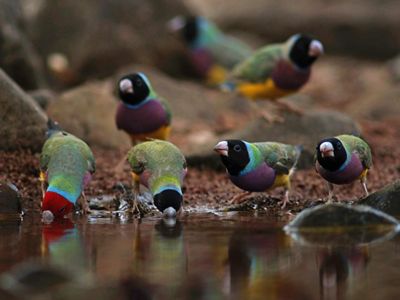
Status: Endangered
The Gouldian Finch is perhaps the most beautiful small bird in the world. The impressive colour of its plumage appealed to bird enthusiasts and hence large number of them were trapped in the wild for the local and international bird trade up until the early 1980s. This along with a parasitic air-sac mite and habitat changes as a result of land clearing and fire are the main causes of their decline.
Fire plays a large role in their survival. In the dry season, they are dependent on controlled fires to burn the undergrowth so that they can find seeds on the ground to feed on. In the wet season, they prefer to live in areas which have been burned in the previous dry season. This produces lush new growth with plenty of seeds for food. Improved burning practices in the northern savannas are helping them make a comeback.
3. Northern Quoll
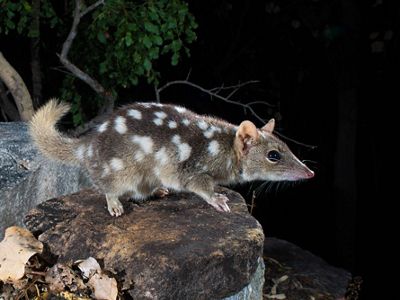
Status: Endangered
The Northern Quoll is a spotted carnivorous marsupial of the north. They feed primarily on invertebrates, but also eat fleshy fruit (particularly figs) and a wide range of vertebrates, including small mammals, birds, lizards, snakes and frogs. They also scavenge on road-kills, around campsites, and in garbage bins. In the wild, males live for about one year, while the maximum recorded for a wild female was about three years of age. In rocky habitats, the lifespan of both sexes appears to be increased to two or three years, and individuals are larger than those living in savanna habitats such as the Kimberley, possibly due to better habitat and reduced predation.
They are susceptible to cane toad toxins, fire and introduced predators such as foxes and cats. The species is now absent from many parts of its former range, particularly the savanna country.
A concern is the imminent arrival of the cane toad. With their poisonous glands, cane toads kill animals such as the Northern Quoll, that eat them. Cane toads pose a threat to barniy (goanna), snakes, koowaniya (Freshwater Crocodile) and linykoorra (Saltwater Crocodile) may also be affected. Animals that already occur in small numbers are most threatened by cane toads as their populations find it harder to cope with the impact.
The impacts of feral animals are exacerbated by extensive wildfires, habitat degradation through over-grazing and urban development which reduce ground cover and hence shelter for these small mammals.
To help protect this highly adaptable species, northern quolls have been transferred on a few offshore toad-free islands. They seem to be thriving on Fish River Station in the Northern Territory and are benefitting from better land management practices in the Kimberley where Nyikina Mangala Rangers conduct surveys to monitor their native animal species closely to ensure that no species will be lost.
4. Purple-crowned Fairy-wren
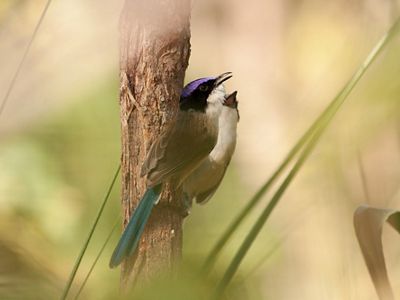
Status: Endangered
The Purple-crowned Fairy-wren is a riparian habitat specialist that occurs in patches of dense river-fringing vegetation. These striking wrens occur as two subspecies. The western subspecies is found in the Kimberley Region of Western Australia and in the Victoria River District of the Northern Territory and is listed as endangered.
They are co-operative breeders where offspring from previous breeding seasons will remain with their parents and help raise subsequent broods. They spend their days flitting around between pandanus, river grasses and shrubs, and scratching in the leaf litter to find their prey of insects and sometimes seeds.
During the breeding season, adult males develop the spectacular bright purple feathers on their crown, bordered by a black face mask and capped with an oblong black spot on top of the head.
Current pastoral practices and fire regimes are detrimental to their preferred habitat and are leading to decline and disappearances of these fairy-wrens. The greatest threat to the species is degradation or loss of habitat. Livestock seeking water eat and trample riparian vegetation, and more frequent and/or more intense fires have also been detrimental in some places. Heavy weed invasion may also have adverse effects now and in the future. Low breeding success has also been largely due to nest predation by feral cats and the introduced Black Rat.
5. Largetooth Sawfish
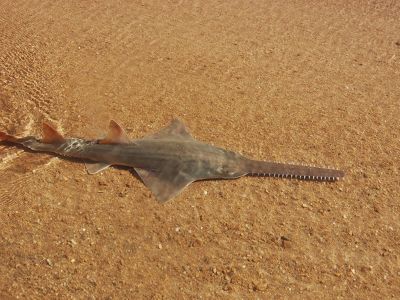
Status: Vulnerable
Sharks and rays are some of the world’s most threatened animals, with a quarter of all species at risk of extinction. Among the sharks and rays, sawfish are some of the most threatened.
The Fitzroy River is home to three species of sawfish – all listed as Vulnerable (Largetooth Sawfish, Dwarf Sawfish and Green Sawfish) – and collectively known as Biyal-biyal by the Nyikina and Mangala people. Our work with these Traditional Owners to create the Walalakoo Healthy Country Plan is helping to safeguard the habitat and flows of the Fitzroy River for these extraordinary fish.
The Largetooth Sawfish, previously known locally as the Freshwater Sawfish, is one of the planet’s largest fish, growing to over 6.5m in length! It is a “euryhaline” species: capable of moving freely across a range of salinities from pure freshwater to the oceans. Its life cycle is complex and fascinating, encompassing a wide variety of habitats – floodplains, billabongs, creeks, rivers, estuaries and marine waters.
Historically this sawfish was a wide-ranging species of tropical regions with four distinct populations – eastern Atlantic, western Atlantic, eastern Pacific and the Indo-west Pacific. It is now extinct or severely depleted across much of this range and is globally listed by the IUCN as Critically Endangered.
Northern Australia represents one of the only remaining population strongholds for this sawfish and although it has also declined significantly here, it is holding on. The relatively pristine nature of large northern Australian rivers are essential for juvenile Largetooth Sawfish.
Structures such as dams and barrages in rivers are barriers to sawfish migration, while dry season water extraction could reduce available river habitat. Connectivity from estuaries through to upstream reaches of rivers is essential for allowing the species to complete its lifecycle.
6. Australian Painted-snipe
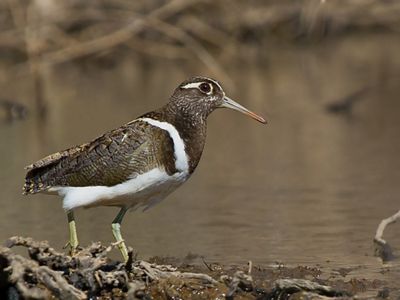
Status: Endangered
The Australian Painted-snipe is small freshwater wader that inhabits many different types of shallow, brackish or freshwater wetlands, especially temporary ones which have muddy margins and small, low-lying islands. They prefer to remain among the cover of wetland vegetation while foraging. They feed at night, probing the soft mud in shallow water with their long bills as they walks pecking at seeds and taking worms, molluscs, insects and some plant-matter.
Females lay three or four dull-coloured, spotted and blotched eggs which are incubated by the male, who also provides most care for the young.
The Australian Painted-snipe can be found in wetlands in all states of Australia. It is more common in eastern Australia, predominantly around the Murray-Darling Basin. Unfortunately, they’re rapidly declining and are rare throughout their range. Causes of their decline are due to destruction of wetland habitat such as drainage and the diversion of water to agriculture and reservoirs, as well as grazing and trampling of wetlands by livestock. It is estimated that since European settlement, approximately 50% of wetlands in Australia have been converted for other uses.
7. Greater Bilby
Status: Vulnerable
Often simply called the bilby, since the extinction of the Lesser Bilby in the middle of last century, Mankarr (as they are known throughout the Western Desert) are an icon of the sandy deserts of the outback. Like most desert dwellers they are nocturnal, spending their days in burrows deep underground to avoid the heat.
These endearing, large and strikingly marked bandicoots were once found across the Australian continent. In fact, at the time of European settlement the Greater Bilby occupied 70% of the Australian mainland. Today, due to a range of threats from feral cats and foxes, habitat destruction and inappropriate fire regimes, it is listed as vulnerable to extinction. It survives only in remote locations in northern and central Western Australia and the Northern Territory as well as a separate population in south-west Queensland.
Greater bilbies are important in the restoration of soil and rejuvenation of vegetation in arid Australia. They use their strong front paws to dig deep holes in soil that enables plant material to fall in and decompose. At the same time, soil is aerated which supports seed germination. Bilbies essentially create numerous compost pits every night.
The Walalakoo Healthy Country Plan was launched at Jarlmadangah Community, south-east of Derby on the May 23, 2017. The launch was supported by funding from the Western Australian Government’s State NRM Program, which is in turn supported by Royalties for Regions.
Help protect threatened species in the Kimberley
Just $35 a month can help conserve 8,400 hectares of existing habitat for the Greater Bilby and other threatened species in the southern Kimberley.
